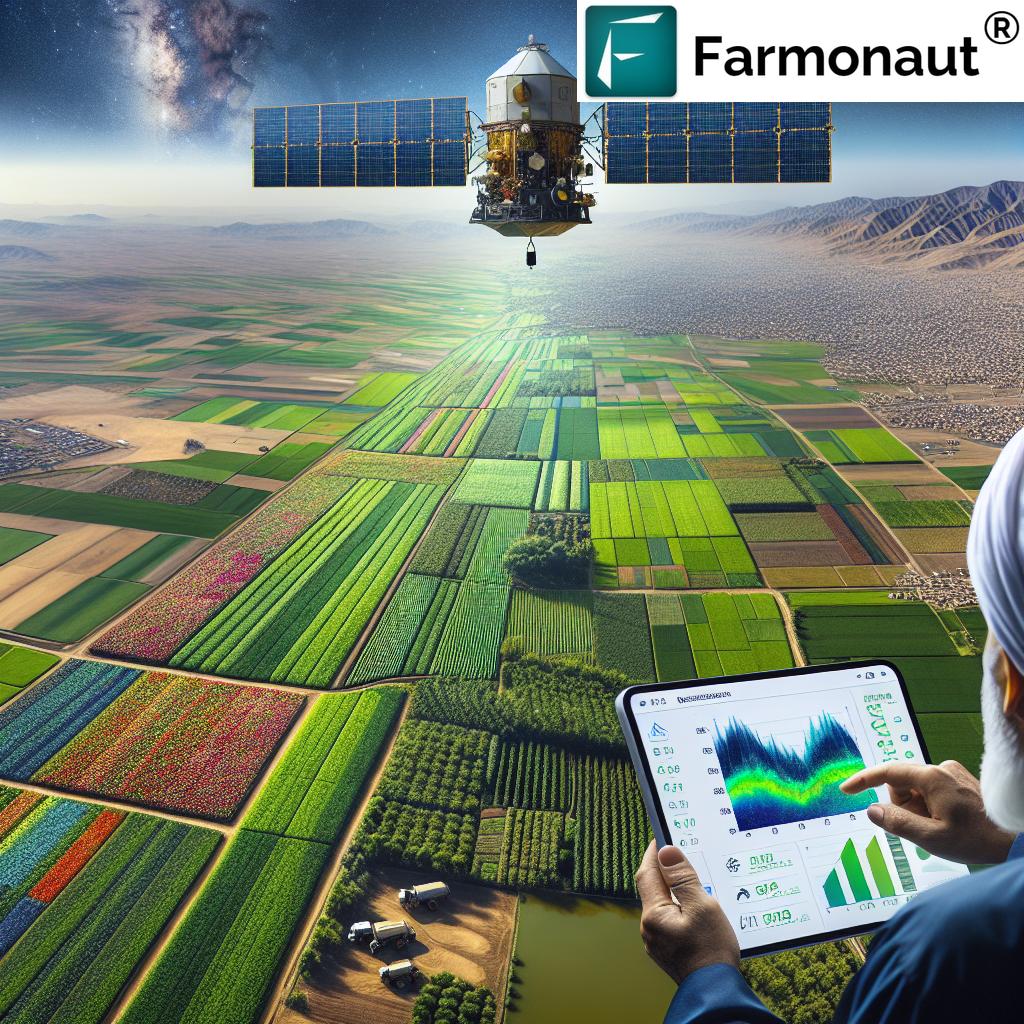2024 Weather Forecast: Essential Agriculture Updates for Indian Farmers’ Crop Management Success

“Farmonaut’s 2024 Weather Forecast blog covers weather updates for over 29 states in India, providing comprehensive agricultural insights.”
Welcome to Farmonaut’s comprehensive 2024 Weather Forecast blog, your essential guide to agricultural success in the coming year. As we embark on this journey through the intricate world of weather forecasting for agriculture, we aim to equip Indian farmers with the knowledge and tools necessary to navigate the challenges and opportunities that lie ahead.
In this extensive guide, we’ll delve into the latest monsoon predictions for India, provide crucial crop management weather updates, and explore cutting-edge precision agriculture technology. Our goal is to help you stay ahead of the weather and boost your agricultural productivity through informed decision-making and innovative farming practices.
The Importance of Weather Forecasting in Agriculture
Weather plays a pivotal role in agricultural success, influencing everything from crop selection to harvest timing. As we step into 2024, understanding and leveraging accurate weather forecasts has never been more critical for Indian farmers. Here’s why:
- Improved crop planning and resource allocation
- Enhanced risk management strategies
- Optimized irrigation and water management
- Better pest and disease control
- Increased overall farm productivity and profitability
At Farmonaut, we recognize the vital importance of timely and accurate weather information for agriculture. That’s why we’ve developed advanced satellite-based farm management solutions to provide you with real-time insights and data-driven recommendations.
2024 Monsoon Predictions for India: What to Expect
The monsoon season is the lifeblood of Indian agriculture, and understanding its patterns is crucial for successful crop management. Based on the latest meteorological data and analysis, here’s what we can expect for the 2024 monsoon season:
- Onset and Duration: The Southwest monsoon is predicted to arrive on time in Kerala, around June 1, 2024. It’s expected to progress normally across the country, covering most regions by early July.
- Rainfall Distribution: Overall, the monsoon is forecasted to be near normal, with rainfall expected to be 96-104% of the Long Period Average (LPA).
- Regional Variations: Central India and the Southern Peninsula are likely to receive above-normal rainfall, while Northwest and Northeast India may experience slightly below-normal precipitation.
- El Niño Impact: The weakening El Niño conditions are expected to transition to neutral by the beginning of the monsoon season, potentially leading to a more favorable rainfall pattern.
These monsoon predictions for India are crucial for planning your agricultural activities. However, it’s important to note that localized variations can occur, and staying updated with real-time weather data is essential for making informed decisions.
Crop Management Weather Updates: Seasonal Breakdown
To help you plan your agricultural activities throughout the year, we’ve compiled a seasonal breakdown of weather forecasts and their potential impact on crop management. This information will assist you in making informed decisions about planting, irrigation, and harvesting schedules.
| Season | Weather Forecast | Potential Agricultural Impact | Recommended Farming Practices |
|---|---|---|---|
| Winter (Jan-Feb) | Mild temperatures, occasional cold waves in North India | Favorable for Rabi crops, potential frost damage in northern regions | Use frost protection methods, adjust irrigation schedules |
| Summer (Mar-May) | Rising temperatures, heat waves in central and northern India | Increased water demand, heat stress on crops | Implement mulching, drip irrigation, choose heat-resistant varieties |
| Monsoon (Jun-Sep) | Near-normal rainfall, regional variations expected | Crucial for Kharif crops, potential flood/drought risks in some areas | Use weather-resistant seeds, implement proper drainage systems |
| Post-Monsoon (Oct-Dec) | Gradual temperature decline, northeast monsoon in southern states | Important for Rabi crop sowing, cyclone risk in coastal areas | Plan for timely sowing, monitor cyclone alerts, adjust crop selection |
These crop management weather updates provide a general overview, but it’s crucial to access localized, real-time data for your specific region. Farmonaut’s satellite-based monitoring system offers precise, field-level insights to help you make the most informed decisions for your crops.
Leveraging Precision Agriculture Technology for Weather-Smart Farming
As we navigate the complexities of changing weather patterns, precision agriculture technology becomes an invaluable tool for Indian farmers. By harnessing the power of satellite imagery, artificial intelligence, and data analytics, we can optimize farm operations and mitigate weather-related risks.
Here’s how Farmonaut’s advanced technology can help you implement weather-smart farming practices:
- Real-time Crop Health Monitoring: Our satellite-based system provides up-to-date information on vegetation health (NDVI), allowing you to quickly identify and address issues caused by weather fluctuations.
- AI-Powered Advisory: Our Jeevn AI system analyzes weather data and crop conditions to provide personalized recommendations for irrigation, fertilization, and pest management.
- Weather-Based Yield Prediction: By combining historical weather data with current conditions, we can help you forecast potential yields and plan accordingly.
- Resource Optimization: Our precision agriculture tools enable you to optimize water and input usage based on real-time weather conditions, reducing waste and improving efficiency.
“Climate-smart farming practices discussed in Farmonaut’s blog can potentially increase crop yields by up to 25% while reducing weather-related risks.”
By integrating these technologies into your farming practices, you can significantly enhance your farm’s resilience to weather variations and boost overall productivity.
Climate-Smart Farming Practices for 2024
As we face increasingly unpredictable weather patterns, adopting climate-smart farming practices is essential for sustainable agriculture. Here are some key strategies to consider for 2024:
- Crop Diversification: Planting a variety of crops can help spread risk and improve resilience to weather fluctuations.
- Conservation Agriculture: Implement minimum tillage, crop rotation, and permanent soil cover to improve soil health and water retention.
- Water-Efficient Irrigation: Adopt drip irrigation or micro-sprinklers to optimize water use based on real-time weather data.
- Climate-Resilient Crop Varieties: Choose drought-tolerant or flood-resistant varieties suited to your region’s climate projections.
- Integrated Pest Management (IPM): Use weather forecasts to anticipate pest outbreaks and implement preventive measures.
- Agroforestry: Integrate trees into farming systems to improve microclimate and enhance resilience to extreme weather events.
Implementing these practices in conjunction with Farmonaut’s precision agriculture technology can significantly enhance your farm’s ability to withstand weather-related challenges and maintain productivity.
State-Specific Weather Forecasts and Agricultural Implications
India’s diverse geography leads to significant regional variations in weather patterns. Here, we provide a brief overview of weather forecasts and their agricultural implications for key states:
- Rajasthan: Expect below-normal rainfall in 2024. Focus on drought-resistant crops and efficient water management techniques.
- Punjab and Haryana: Near-normal monsoon predicted. Prepare for potential heatwaves during summer months.
- Uttar Pradesh: Slightly above-normal rainfall expected. Plan for proper drainage to prevent waterlogging in low-lying areas.
- Maharashtra: Normal to slightly above-normal monsoon forecast. Monitor for heavy rainfall events in the Konkan region.
- Karnataka and Tamil Nadu: Above-normal rainfall likely during the Northeast monsoon. Consider adjusting planting schedules for rain-fed crops.
Remember, these are general forecasts, and localized variations can occur. Use Farmonaut’s precision agriculture tools to access field-specific weather data and make informed decisions for your crops.

Agricultural Machinery Trends for Weather-Adaptive Farming
As we adapt to changing weather patterns, agricultural machinery trends are evolving to meet the needs of climate-smart farming. Here are some key developments to watch in 2024:
- Smart Tractors: GPS-guided tractors with weather sensors for precision planting and harvesting.
- Drones for Crop Monitoring: Use of drones equipped with multispectral cameras for real-time crop health assessment.
- Weather-Responsive Irrigation Systems: Automated systems that adjust water application based on real-time weather data and soil moisture levels.
- Climate-Controlled Greenhouses: Advanced structures with automated climate control for year-round cultivation.
- Precision Seeders: Equipment that optimizes seed placement based on soil conditions and weather forecasts.
While these technologies can significantly enhance weather-adaptive farming, it’s important to choose equipment that aligns with your specific needs and scale of operation. Farmonaut’s advisory services can help you make informed decisions about agricultural machinery investments.
Sustainable Farming Techniques for Changing Climate Conditions
Adopting sustainable farming techniques is crucial for long-term agricultural success in the face of changing climate conditions. Here are some approaches to consider:
- Cover Cropping: Plant cover crops during fallow periods to improve soil health and reduce erosion.
- Organic Farming: Reduce chemical inputs and focus on building soil organic matter for improved water retention.
- Permaculture: Design farming systems that mimic natural ecosystems for increased resilience.
- Rainwater Harvesting: Implement systems to capture and store rainwater for use during dry periods.
- Biochar Application: Use biochar to improve soil water-holding capacity and nutrient retention.
- Agroecology: Apply ecological principles to farming systems for enhanced biodiversity and resilience.
These sustainable techniques, when combined with Farmonaut’s precision agriculture technology, can help you build a more resilient and productive farm in the face of climate variability.
Leveraging Weather Data for Financial Planning in Agriculture
Accurate weather forecasting doesn’t just impact crop management; it’s also crucial for financial planning in agriculture. Here’s how you can use weather data to make sound financial decisions:
- Crop Insurance: Use weather forecasts to assess risk and choose appropriate crop insurance policies.
- Investment Planning: Make informed decisions about investments in irrigation systems or climate-controlled structures based on long-term weather trends.
- Loan Management: Plan loan repayments considering expected yields based on weather forecasts.
- Market Timing: Use weather data to anticipate supply fluctuations and time your market entry for better prices.
Farmonaut’s precision agriculture tools can provide you with the data and insights needed to make these critical financial decisions. Our farm loan calculator can help you assess different scenarios based on weather forecasts and expected yields.
API Integration for Advanced Weather Insights
For agribusinesses and tech-savvy farmers looking to integrate weather data directly into their systems, Farmonaut offers a powerful API solution. Our Weather API provides access to high-resolution satellite data and weather forecasts, allowing you to build custom applications and decision support tools.
To learn more about integrating our weather data into your systems, check out our API Developer Docs.
Conclusion: Embracing Weather-Smart Agriculture for a Prosperous 2024
As we look ahead to 2024, the importance of weather-smart agriculture cannot be overstated. By leveraging accurate weather forecasts, adopting climate-smart farming practices, and utilizing precision agriculture technology, Indian farmers can navigate the challenges posed by changing weather patterns and achieve agricultural success.
Remember, Farmonaut is here to support you every step of the way with our advanced satellite-based monitoring systems, AI-powered advisories, and real-time weather insights. By staying informed and adapting your farming practices, you can turn weather challenges into opportunities for growth and sustainability.
Let’s work together to make 2024 a year of agricultural prosperity, resilience, and innovation. Stay weather-smart, stay ahead!
FAQs
- Q: How accurate are the weather forecasts provided by Farmonaut?
A: Farmonaut uses advanced satellite technology and AI algorithms to provide highly accurate weather forecasts. However, as with all weather predictions, there can be some variability, especially for long-term forecasts. - Q: Can Farmonaut’s technology be used for all types of crops?
A: Yes, our satellite-based monitoring and AI advisory systems are designed to work with a wide range of crops, from grains and pulses to fruits and vegetables. - Q: How often is the weather data updated on Farmonaut’s platform?
A: We provide daily updates for short-term forecasts and regular updates for long-term seasonal forecasts. Real-time satellite data is typically refreshed every 1-3 days, depending on satellite passes and cloud cover. - Q: Does Farmonaut provide localized weather alerts?
A: Yes, our system can send personalized alerts for extreme weather events, such as heavy rainfall or heatwaves, specific to your farm’s location. - Q: How can I access Farmonaut’s weather forecasting services?
A: You can access our services through our web application, mobile apps (available for both Android and iOS), or by integrating our API into your existing farm management systems.
















